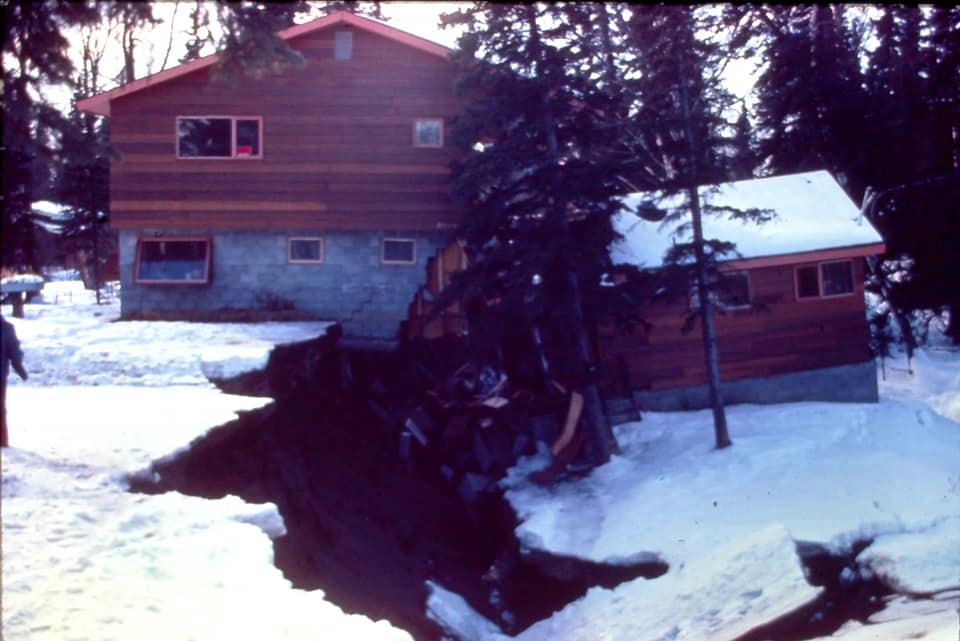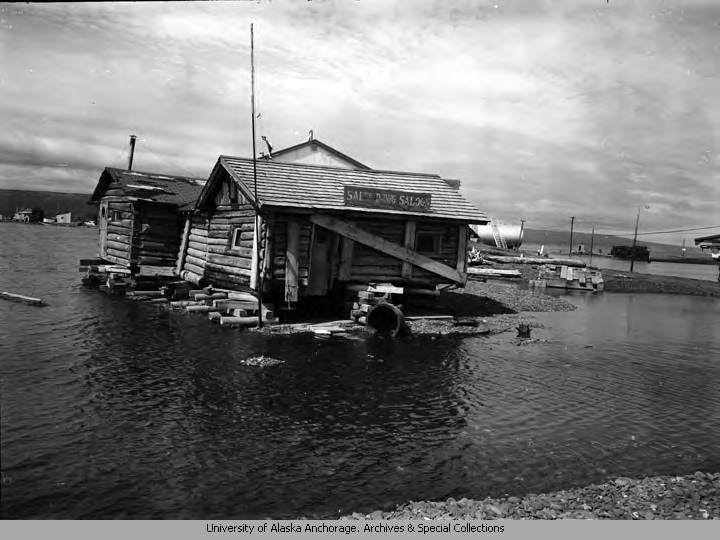With the continuing cleanup and demolition of the city following the March 27 earthquake, in 1964 outsiders moved in to get involved with the rebuilding. In time they would transform the city, expanding the commercial and institutional parts far beyond the existing downtown and small outposts. There was much debate and discussion — and disagreement — on how the city should develop and how it should look and feel. The quake was at least a boost to Ralph’s career — confident of continuing work, he finally left Manley & Mayer for solo pursuits.
Oil tanks on fire in Seward, Alaska a few minutes after the shaking stopped on March 27, 1964. Photo courtesy Philip Richardson, from Facebook.
A “cob job” concrete block building failure, downtown Anchorage. Photo courtesy Grover Wright, on Facebook.
Bootleggers Cove looking back toward downtown from near the west end of 9th Ave. in 1964. Photo courtesy Grover Wright, from Facebook.
Four Seasons Apartments at 9th and M. Photo courtesy Gregory Robinson, on Facebook.
3rd and 4th Avenues looking east from E St. in 1964. Photo courtesy Kay Thomas, on Facebook.
Turnagain neighborhood, extensive damage due to liquefaction of blue clay layers below the surface. Photo courtesy Grover Wright, on Facebook.
Turnagain “split level”. Photo courtesy Grover Wright, on Facebook.
The 4th Ave. Theater, once the grandest movie palace in the north has been mothballed since 2004. The Bob Hamilton-designed penthouse apartment is visible on the roof. Beyond in the background, the Key Bank Building that was damaged in the Nov. 30, 2018 quake is undergoing a gut renovation and addition. Photo by Clark Yerrington, 12/14/21.
The Empress Theater used to sit in the portion of this building behind the yellow cab. It was used as a bank and then various restaurants and bars after being decommissioned as a theater in the ‘60s, and torn down in 2013 after 97 years on its 4th Ave. site. Photo by Clark Yerrington, 12/14/21.
Land’s End on the tip of the Homer Spit in 1961. This would be what Ralph saw on his visit a couple of years later. Photo from Steve McCutcheon Collection, Anchorage Museum at Rasmuson Center.
Lands End post-quake in 1964. Photo from Anchorage Museum at Rasmuson Center.
Lands End in 1964 after being raised up on cribbing. A small boat harbor was created on part of the end of the spit and the excavated soil used to build up adjacent areas where the land was lowered by the quake and then further eroded by the tides. Photo from University of Alaska Anchorage, Consortium Library, Archives and Special Collections.
Photo from University of Alaska Anchorage, Consortium Library, Archives and Special Collections.
The Salty Dawg Saloon on the Homer Spit in 1961. Photo from Steve McCutcheon Collection, Anchorage Museum at Rasmuson Center.
The Salty Dawg in 1964 after the earthquake, suffering similarly to Lands End. The building was also elevated and the land filled in underneath. Photo from Robert and Wilma Knox Papers, University of Alaska Anchorage, Consortium Library, Archives and Special Collections.
The Salty Dawg on 7/20/82. It looks better presently, having been maintained well in recent years. Photo from Delores Mann, University of Alaska Anchorage, Consortium Library, Archives and Special Collections.
April 10, 1964 front page of the Anchorage Times with lead story on post-quake tidal flooding on the Kenai Peninsula. Photo courtesy Roberta Carney, on Facebook.
The former Bob Hamilton-designed FAA offices at 6th Ave. and G St., now Anchorage City Hall. Photo by Clark Yerrington, 12/14/21.
The city of Anchorage acquired the building in 1992 and the remodel design was by Koonce Pfeffer Architects. This addition at the back of the building provided a loading dock and covered entrance. The doors here and on the 6th Ave. side, opposite were painted yellow in homage to the color of the original building. Photo by Clark Yerrington, 12/14/21.
Tyonek Buildings by Mayo and Coolidge Architects, 16th Ave. and C St., part of the expansion of commercial activity beyond 4th and 5th Ave. in the 1960s. Photo by Clark Yerrington, 12/14/21.
“None grander in Anchorage [in 1964].” Main campus building at Alaska Methodist University. Edward Durell Stone Architect; Manley and Mayer, Associated Architect. Photo by Clark Yerrington, 12/14/21.























